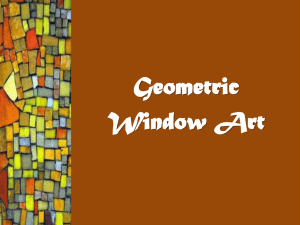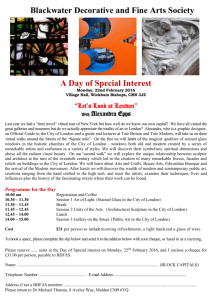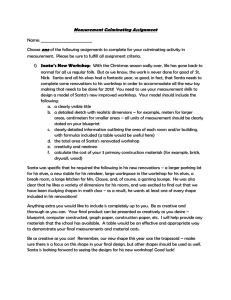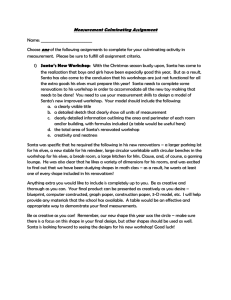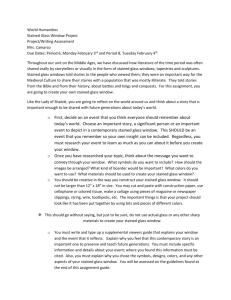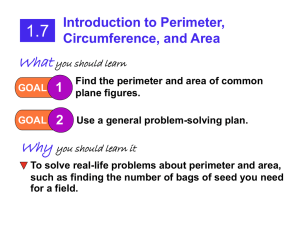AuthenticLearningtemplate3 — Sheri Turner
advertisement
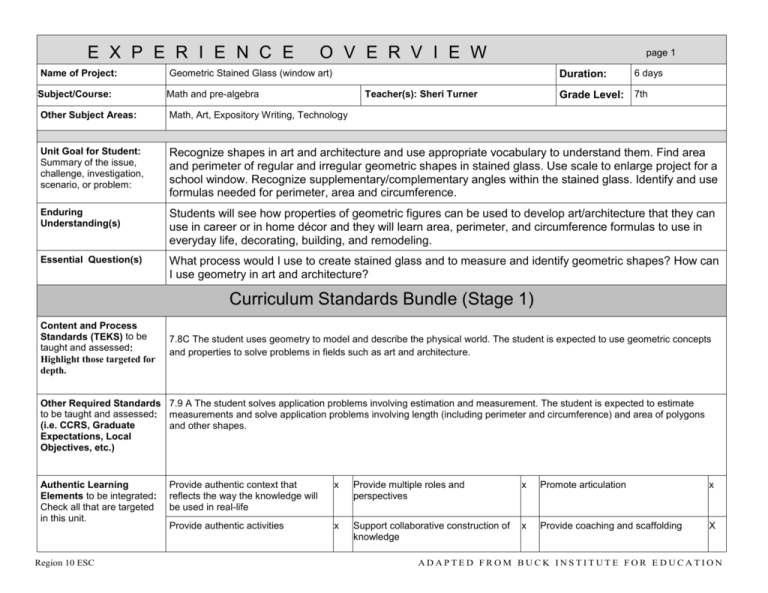
E X P E R I E N C E O V E R V I E W page 1 Name of Project: Geometric Stained Glass (window art) Subject/Course: Math and pre-algebra Other Subject Areas: Math, Art, Expository Writing, Technology Unit Goal for Student: Summary of the issue, challenge, investigation, scenario, or problem: Recognize shapes in art and architecture and use appropriate vocabulary to understand them. Find area and perimeter of regular and irregular geometric shapes in stained glass. Use scale to enlarge project for a school window. Recognize supplementary/complementary angles within the stained glass. Identify and use formulas needed for perimeter, area and circumference. Enduring Understanding(s) Students will see how properties of geometric figures can be used to develop art/architecture that they can use in career or in home décor and they will learn area, perimeter, and circumference formulas to use in everyday life, decorating, building, and remodeling. Essential Question(s) What process would I use to create stained glass and to measure and identify geometric shapes? How can I use geometry in art and architecture? Duration: Teacher(s): Sheri Turner 6 days Grade Level: 7th Curriculum Standards Bundle (Stage 1) Content and Process Standards (TEKS) to be taught and assessed: Highlight those targeted for depth. 7.8C The student uses geometry to model and describe the physical world. The student is expected to use geometric concepts and properties to solve problems in fields such as art and architecture. Other Required Standards 7.9 A The student solves application problems involving estimation and measurement. The student is expected to estimate to be taught and assessed: measurements and solve application problems involving length (including perimeter and circumference) and area of polygons (i.e. CCRS, Graduate and other shapes. Expectations, Local Objectives, etc.) Authentic Learning Elements to be integrated: Check all that are targeted in this unit. Region 10 ESC Provide authentic context that reflects the way the knowledge will be used in real-life x Provide multiple roles and perspectives x Promote articulation x Provide authentic activities x Support collaborative construction of knowledge x Provide coaching and scaffolding X ADAPTED FROM BUCK INSTITUTE FOR EDUCATION Provide access to expert performances and the modeling of processes 21st Century Skills/NETS to be taught and assessed: x Promote reflection Assessments X X Information, Media, or ICT Literacy (NETS 3) X Communication and Collaboration (NETS 2) x Life and Career Skills X Critical Thinking/Problem Solving (NETS 4) x x Digital Citizenship, Technology Operations and Concepts (NETS 5and 6) X (STAGE 2) page 2 Online video of how to design stain glass. – Flipped video Online video of stain glass used in art and architecture in USA. Teacher to present the idea of creating a stain glass to be (hypothetically) placed in the entry of our school building. (students can choose to design one for our school or for the MISD elementary school they attended). Summative Assessments: Major Products and/or Performances - Test over formulas in these standards. – test grade Students will write an essay that walks reader through the process they used to create product and find measurements, calculate area, perimeter, etc. Typed and submitted through edmodo. Students will tell how they could use this in future and any examples they have seen before. – Test grade Formative Assessments (During Learning) - Stained glass product – art – daily grade List of shapes and their properties that are included in their product. – daily grade Calculations of area, perimeter, and circumference of figures in their product – daily grade. Resources Needed Materials: Resources: Region 10 ESC Provide for authentic assessment of learning within the tasks Creativity and Innovation (NETS 1) A S S E S S M E N T Entry Event to launch inquiry, engage students: x Laptop/projector/internet, art supplies, measurement tools, formula posters, expert video Online videos of how to design stained glass, expert examples , examples in USA ADAPTED FROM BUCK INSTITUTE FOR EDUCATION Reflection Methods (Individual, Group, Whole class – Introduction videos, examples, videos. Voting on school winner through survey, online polls on and/or Whole Class) favorite part of project and most difficult part of project. Group – Focus groups on formulas to use to figure out regular and irregular shapes area and perimeter and present to other students. Individual – process essay L E A R N I N G E X P E R I E N C E S ( S T A G E 3 ) Students will design a stained glass to use in entry to school building. They will use scale to enlarge their design. The creation will be done in groups. Students will individually calculate perimeter, area, circumference, etc. They will be working with irregular and regular geometric shapes. School will vote on their favorite product. Students will discuss properties of shapes, triangles, quadrilaterals, circles, angles, and polygons. Students will discuss how to find the calculations. Students will give a written explanation of the processes used to calculate measurements. When we begin a future unit on surface area, we will use the products again for calculations. Day 1: Introduce (one video flipped on previous night) Day 2: Create stained glass and discuss properties in focus groups. Day 2 and 3 focus groups will be based on the stained glass groups. (Groups will be assigned via edmodo and students will receive online directions via a flipped video on the evening of day one so they are ready to work on day 2) Day 3: Present focus group findings and finish the design. (flipped video to be shown on evening of day 3 for homework – flipped – so students have been introduced to formulas and how to use them. Day 4: New focus groups based on student need will be formed and they will discuss formulas needed to calculate perimeter, area and circumference. Groups may choose how to share their findings, orally, on edmodo, on chart paper, graph, etc. (reports from day 4 focus group findings posted on Edmodo for flipped classroom interpretation). Day 5: Calculations of area, perimeter, circumference (Individual) Students can use findings from day 4 focus groups. Day 6: Student will write about the process they went through in all levels of project (differentiate essays). Students will vote on their favorite product. Online edmodo polls posted for flipped homework. Pre AP will scan all products and create a web site with student work upon completion of project. Region 10 ESC ADAPTED FROM BUCK INSTITUTE FOR EDUCATION Region 10 ESC ADAPTED FROM BUCK INSTITUTE FOR EDUCATION
